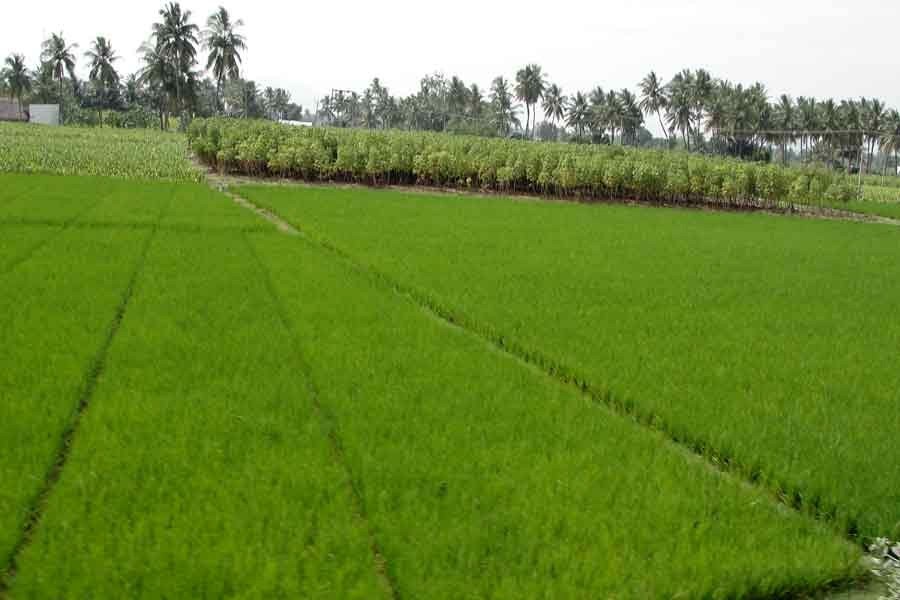In a country with scarce land and a large population, the pattern of land useis highly important. It is more so following reports that cultivated land in Bangladesh has been declining by 0.31 to 1 percent per year. A selection of data set generated by a survey shows that only one-fifth of the land is now being used in Aus season (Kharif-1) compared to more than half of the land in the 1980s. To be more specific, as high as one-third of the cultivated land was devoted to Aus paddy three decades back compared to only 5.0 percent in recent years.Likewise, two-thirds of lands are being used in Amon season (Kharif-11) as against four-fifths in comparable periods. It appears that both seasons witnessed a substantial wane in land use during the comparable periods. However, possibly to compensate for the loss of land in two seasons, land under cultivation in Boro season went up from a little over half to about 90 percent during the period under review. Specifically, cultivated land under paddy in this season went up from one-fifth to one-half. There has been another development over time. Maize crop now accounts for about one-tenth of cultivated land in Boro season - a crop that was unknown to farmers even in 2000. Secondly, out of the land owned by rural households, the homestead size has squeezed over time while land under garden and pond increased indicating growing land use for vegetables, horticulture crops and fish. Thirdly, only one-third of the cultivated land had access to irrigation in 1988; it rose to more than four-fifths by 2014. Admittedly, it was shallow tube-wells (STWs) - the leader of the 'lead input' called irrigation - that engineered the march by tripling area under irrigation from only 16 percent to about 60 percent in 2014. Indigenous method once captured one-tenth of irrigated land; now reduced only to 2.0 percent due to drying up of rivers, canals.
The most important observation to draw policy level attention is the fact that despite the advent of the modern technology, roughly 40 percent of the cultivated land continues to be single-cropped till now. Quite expectedly, it is the large and medium farms which have more single-cropped land than small farms, and areas with rain-fed and surface-water agriculture has more of this than areas with groundwater irrigation. And finally, low land and very low lying areas have most of the single cropped lands (low: about 50 percent, very low about 80 percent). We need to think seriously how to convert those areas into multi-cropped to avert food crisis. A mapping is necessary to locate specific areas for technological interventions.
Contrary to the popular perceptions, the data base shows that yield rate in terms of paddy has risen over time. The yield of Boro is estimated to be about 6.0 tons/ha - about twice the yield of 2000, and yield of MV Amon has increased from 3.3 to 3.8 tons/ha over the same period. Similar is the case with Aus yield. Interestingly, yield of maize shot up from barely 1.0 ton/ha to about 8.0 tons/ha that could be the reason for an increased area coming under maize cultivation relegating wheat and other crops.
Which varieties of rice are grown in fields? In the Boro season, Bridhan 28 and 29 are reported to capture almost 60 percent of the sown areas compared with 20 percent in 2000. Hybrid varieties were almost non-existent in 2000 but swelled to one-fifth of the area in 2014. In the Amon season, Swarna variety occupies about 30 percent of sown area compared to 13 percent in 2000. Interestingly, BR11 topped the list in 2000 Amon season capturing about 25 percent of area but fell to only 6.0 percent in 2014. Two important observations are worth notingso far as choice of variety is concerned. First, a total of 16 varieties of rice in Aus and Amon and 11 varieties in Boro season are grown in Bangladesh reflecting crop diversity and thus averting a fall in yield rate. Second, farmers tend to shift to newer varieties taking into consideration many attributes. Although yield consideration comes first, period of maturity, market demand etc.; are also determinant factors for choice. For example, Bridhan 28 with relatively low yield is preferred to 29 because of the former's slight edge in maturity and taste. Thirdly, the marginal rise in Aus area as mentioned before could be adduced to the advent of modern Aus variety and increased yield. Especially AC-1 and 2 provides more than 5.0 tons/ha and IR 50 and Chandina provides about 4.0 tons/ha. Finally, the policy implication is that since the future of sustainable food grain production in Bangladesh depends largely on rice grown in these two low-yield and high risk seasons, serious efforts should be put into technological innovation through research and extension. The shift should be from Boro to Aus and Amon that need less ground water and fertilisers.
In the most recent years, the land use pattern reveals interesting insights that hardly draws our attention. Production of non-cereal crops like fruits and vegetables, spices seem to be capturing more land. In other words, rise in per capita income and a change in food habits and increasing awareness about health are contributing to a kind of market demand that forces farmers to rationalise their resource allocation. The market signal has tremendous ramification which policymakers should take into cognizance.
Abdul Bayes is a formerProfessor of Economics at Jahangirnagar University and currently an Adjunct Faculty, East West University. [email protected]


